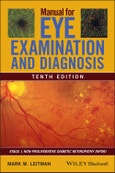Manual for EYE EXAMINATION AND DIAGNOSIS
Now in its tenth edition, Manual for Eye Examination and Diagnosis is the leading introductory clinical textbook in the field, providing concise and practical coverage of anatomy, instrumentation, differential diagnosis and treatment of ophthalmic diseases and disorders. This accessible resource offers clear explanations of current diagnostic techniques, equipment, and best practice; hundreds of full-color clinical photographs and diagrams; and step-by-step guidance on a range of key procedures. Author Mark W. Leitman, a practicing Ophthalmology specialist with nearly five decades’ experience, provides the foundational knowledge required to excel on an ophthalmology rotation.This is a must-have companion for medical students and junior doctors, trainee ophthalmologists and optometrists, optometry nurses, and ophthalmic technicians.
Table of Contents
Preface v
Introduction to the eye team and their
Instruments vi
1 Medical history 1
Table 1 - Common chief complaints 1
Medical illness 3
Medications (ocular side effects) 4
Family history of eye disease 7
2 Measurement of vision and refraction 9
Visual acuity 9
Optics 10
Refraction 14
Contact lenses 18
Common problems 21
Refractive surgery 21
3 Neuro-ophthalmology 28
Eye movements 28
Table 2 - Extraocular muscles 30
Table 3 - Nerves to ocular structures 30
Strabismus 31
Table 4 - Types of eye-turn 32
Table 5 - Comparison of paralytic and nonparalytic strabismus 36
Cranial nerves III-VIII 37
Nystagmus 41
Common brain tumors 47
The pupil 49
Adie’s pupil (tonic pupil) 51
Visual field testing 52
Table 6 - Causes of small (miotic) and large (mydriatic) pupil (Fig. 125) 53
Color vision 56
Circulatory disturbances affecting vision 56
Table 7 - Visual disturbances due to compromised blood flow (Fig. 81) 58
4 External structures 61
Lymph nodes 61
Lacrimal system 61
Failure of the tear to reach the puncta 68
Obstruction at the puncta or canaliculus 68
Tearing due to NLD obstructions 69
Table 8 - Common topical anti-infectives 70
Lids 71
Lashes 74
Phakomatoses 77
Anterior and posterior blepharitis 78
5 The orbit 83
Imaging 83
Sinusitis 84
Exophthalmos 87
Enophthalmos 88
6 Slit lamp examination 91
Cornea 91
Corneal epithelial disease 93
Table 9 - Superficial punctate keratitis (commonly causes photophobia) 94
Table 10 - Conjunctivitis - redness more pronounced in peripheral conjunctiva (see Figs 305 and 395) 96
Corneal endothelial disease 100
Corneal transplantation (keratoplasty) 102
Conjunctiva 108
Sclera 114
7 Glaucoma 117
Glaucoma vs. glaucoma suspect 118
The iridocorneal angle 119
The optic disk (optic papilla) 120
Signs of nerve fiber damage 122
Medical treatment (Table 11) 125
Table 11 - Common glaucoma medications and side effects 126
Table 12 - Common types of glaucoma 134
8 Uvea 137
Malignant uveal tumors 139
Inflammation of the uvea (uveitis) 142
Table 13 - Common causes of an injected conjunctiva (Fig. 395) 144
Anti-inflammatories 144
Table 14 - Ocular Anti-inflammatories (see Fig. 367) 145
Table 15 - Topical Anticholinergics 147
Table 16 - Causes of Uveitis 148
9 Cataracts 158
Laser-assisted cataract surgery 163
Some complications of cataract surgery 165
10 The retina and vitreous 168
Retinal anatomy 168
Fundus examination 171
Table 17 Scheie classification of hypertensive retinopathy (see Fig. 486) 179
Table 18 - Blood sugar levels in diabetes 186
Age-related macular degeneration 188
Central serous chorioretinopathy 192
Pseudoxanthoma elasticum 193
Albinism 195
Retinitis pigmentosa 196
Retinoblastoma 198
Retinopathy of prematurity 198
Vitreous 199
Retinal holes 204
Retinal detachment 206
Appendix 1: Hyperlipidemia 209
Appendix 2: Amsler grid 211
Index 212








